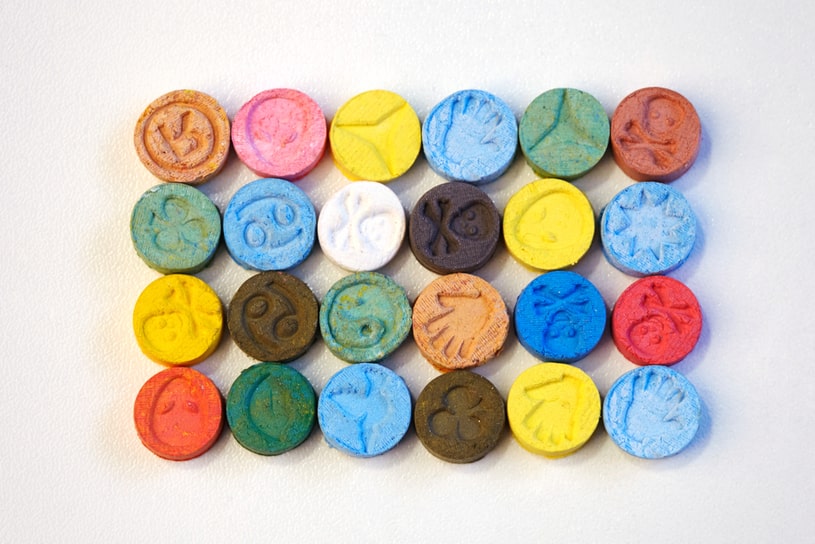Ecstasy use is still a problem among youth in areas all over the world. As per the 2017 Australian Secondary Schools Survey, 5% of students between the ages 12-17 consumed MDMA in the past year.
Table Of Contents:
Ecstasy, or MDMA, is popular because it’s a stimulating drug that facilitates social engagement, feelings of euphoria, and general excitement. Unfortunately, an ecstasy user will fail a drug test if they haven’t metabolized ecstasy out through blood or urine. For this reason, a lot of users take an interest in learning about how long MDMA stays in your system.
MDMA Half-life and Pharmacokinetics
The half-life of molly is estimated to be 8-9 hours. After this period, half of the drug has been wiped out of the system. It takes about 40 hours for 95 percent of E to leave your system.
The body similarly metabolizes ecstasy as other substances. The method of consumption affects the metabolism and thus how long MDMA stays in your system. The metabolism of molly begins in the stomach, after ingesting a pill. The metabolism differs for those who prefer to snort it. After ingesting a pill, it’s absorbed into the bloodstream through the small intestine. This takes between 30 and 60 minutes.

Ecstasy then travels to the lungs, where it becomes oxygenated. This allows it to pass through the blood-brain barrier, a membrane that protects the brain from certain compounds that are unhealthy. From this point forward, the liver processes the drug. The effects usually falter after 6 or 7 hours, but ecstasy remains in the body for up to 50 hours.
Research suggests that molly’s metabolites can remain in your body for up to six days. However, they usually aren’t measured on conventional drug tests.
How Long Does Molly Stay In Urine?
Ecstasy remains detectable in the urine for much longer than it does in the blood. The blood clears Ecstasy out of the bloodstream in less than 24 hours. However, traces of ecstasy are present in the kidneys – which process toxins for urinary excretion – for at least 40 hours.
If urine is too alkaline (less acidic or too high on the pH scale), ecstasy isn’t metabolized as fast. It can stay for longer than 3 days.
Tests can also detect HMMA, which is a metabolite of Ecstasy. MDMA drug tests that screen for HMMA can prove someone used ecstasy up to 5 days after its intake.
However, according to the SAMHSA limits of 250 ng/mL for MDMA, urine specimens were less likely to show up after 48 hours past the consumption.
How Long Does Love Drug Stay In Blood?
The body excretes drugs quickest through the blood. In most cases, tests only detect MDMA in the bloodstream within 24 hours of taking a dose. This is because the body processes the drug out of the blood so it makes its way into other organs, such as the kidneys, where it can be further broken down for elimination.
Advanced MDMA testing kits can detect HMMA in the blood, as well. When testing for HMMA, tests can determine its usage from a blood test up to 3 days after taking the drug.
How Long Does MDMA Stay In Hair?
Drugs remain in the hair for much longer than they do in bodily fluids. This is because hair does not go through the same cycle as urine and blood. Tests can detect MDMA in hair for more than three months after using the drug.
Hair testing requires proper analysis and lab equipment. This is why drug tests do not often include hair testing.
The MDMA drug test can be performed with the hair longer than 3 cm. Molly will not appear in hair immediately after it’s taken. However, it remains for much longer. For this reason, hair MDMA testing kits are usually given for people when testing for drug use over a longer period.
How To Become Clean and Sober Faster?
These are some tips for how to get the drug out of the system. These tips may not be entirely effective on their own, but they can contribute to quicker excretion:
- Stop using ecstasy entirely. This is obvious but also necessary. Some people think that tests won’t detect small amounts of MDMA. This simply isn’t true. Lower doses are excreted a bit quicker, but tests detect any amount of drugs in the system. The more time that passes between ingesting it and taking a drug test, the less likely for the body to detect it.
- Increase the acidity of urine. The pH of urine determines how long MDMA will stay in the system. Alkaline urine does not metabolize as quickly as acidic urine.
- There are supplements that promote the elimination of MDMA. In particular, supplements that increase the activity of the CYP2D6 enzyme, which is responsible for breaking down many drugs, will help the drug pass quickly through the body. Conversely, avoid taking drugs that decrease the activity of CYP2D6 – this will cause the ecstasy to remain system much longer.
Note that taking any additional supplements and substances may create dangerous interactions. It’s not advised to take any supplements to avoid hazardous side effects.
- Exercise. Regular exercise helps improve circulation and having healthy circulation helps remove toxins and drugs from the body quickly. Living a sedentary life will cause drugs and all manner of toxins to remain in your body for longer periods of time.
- Stay hydrated. Staying hydrated is important for all bodily functions – including the excretion of foreign substances. Hydration helps excretion primarily by providing the fluids needed for urinary elimination. This is even more important if one mixed ecstasy with alcohol.
Factors that Affect Detection Time
Drug tests are generally accurate, but there are several things to consider. These factors influence the outcome of drug tests. A 2010 study found that the antidepressant trazodone can lead to false positives on a commercial enzyme immunoassay test (Ecstasy EMIT II assay) that detects MDMA in a urine sample.
- The time someone takes a test compared to the time that drugs were last used will impact the results.
- The laboratory and MDMA test kit used will significantly impact the results of the test. Low-quality equipment could lead to a misdiagnosis.
It is essential to keep these things in mind if there is a necessity of taking a drug test soon.
Even though it is commonly encountered as a “party drug,” it must not be taken lightly. More than half a million adults surveyed in 2014 were found to be current ecstasy users. It is a shocking figure, given ecstasy’s high probability of health as well as addiction threat.

Awareness of how long MDMA stays in your system is essential. Users who go through situations relating to their physical or mental health due to ecstasy stay in the system must join an inpatient treatment program to gain essential support. A mental health professional can guide the user through the process of any withdrawal symptoms you might have.
In case the individual suspect someone who is getting a negative side effect due to the presence of MDMA in their system, it is important to call 911 immediately for information on support and treatment facilities. Moreover, consult specialized physicians or rehab centers for further support and medical facilities.
Page Sources
- Guerin, N. & White, V. (2018). ASSAD 2017 Statistics & Trends: Australian Secondary Students’ Use of Tobacco, Alcohol, Over-the-counter Drugs, and Illicit Substances. Cancer Council Victoria, 2018, https://www.health.gov.au/sites/default/files/secondary-school-students-use-of-tobacco-alcohol-and-other-drugs-in-2017.pdf
- de la Torre R, Farré M, Roset PN, Lopez CH, Mas M, Ortuño J, Menoyo E, Pizarro N, Segura J, Cami J. Pharmacology of MDMA in humans. Ann N Y Acad Sci. 2000 Sep, https://pubmed.ncbi.nlm.nih.gov/11085324/
- Kalant H. The pharmacology and toxicology of "ecstasy" (MDMA) and related drugs. CMAJ. 2001;165(7):917-928, https://www.ncbi.nlm.nih.gov/pmc/articles/PMC81503/
- Barnes AJ, Scheidweiler KB, Kolbrich-Spargo EA, Gorelick DA, Goodwin RS, Huestis MA. MDMA and metabolite disposition in expectorated oral fluid after controlled oral MDMA administration. Ther Drug Monit. 2011;33(5):602-608, https://www.ncbi.nlm.nih.gov/pmc/articles/PMC3178664/
- Abraham TT, Barnes AJ, Lowe RH, et al. Urinary MDMA, MDA, HMMA, and HMA excretion following controlled MDMA administration to humans. J Anal Toxicol. 2009; 33(8):439-446, https://www.ncbi.nlm.nih.gov/pmc/articles/PMC3159864/
- Gryczynski J, Schwartz RP, Mitchell SG, O'Grady KE, Ondersma SJ. Hair drug testing results and self-reported drug use among primary care patients with moderate-risk illicit drug use. Drug Alcohol Depend. 2014;141:44-50, https://www.ncbi.nlm.nih.gov/pmc/articles/PMC4080811/
- Logan BK, Costantino AG, Rieders EF, Sanders D. Trazodone, meta-chlorophenylpiperazine (an hallucinogenic drug and trazodone metabolite), and the hallucinogen trifluoromethylphenylpiperazine cross-react with the EMITII ecstasy immunoassay in urine, J Anal Toxicol, 2010 Nov, https://pubmed.ncbi.nlm.nih.gov/21073812/
- Center for Behavioral Health Statistics and Quality, Behavioral health trends in the United States: Results from the 2014 National Survey on Drug Use and Health (HHS Publication No. SMA 15-4927, NSDUH Series H-50), 2015, https://www.samhsa.gov/data/sites/default/files/NSDUH-FRR1-2014/NSDUH-FRR1-2014.pdf




